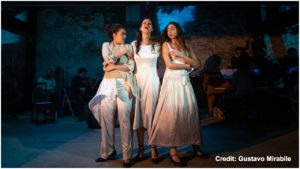
Bare Opera 2019 Review: Maria de Buenos Aires
Kaleidoscopic Production Immersed Viewer In World of Tango
By Logan MartellOn Friday, April 5, 2019, Bare Opera kicked off their production of Astor Piazzolla’s “Maria de Buenos Aires.” Staged in The Bellewether of New York City, the venue, along with director Malena Dayen’s approach, supported by strong choreography from Troy Ogilvie, resulted in an immersive musical experience.
The striking and surreal events of Maria’s dramatic journey are conveyed through movement and interaction nearly as much as the singing. Given the reduced size of the cast, it was not uncommon for them to assume new roles and relationships amongst themselves after emerging from huddles, line-ups, and various seating arrangements. One example of this came for Maria’s death, where Mouna R’miki is seen being laid out and yet, when presenting a body in a manner like a funeral procession, the cast hauls in the seeming corpse of Marcelo Guzzo. This sense of blurred identities is reinforced by the choice in costumes designed by Taylor Mills, with the cast sharing a khaki-based aesthetic and at least two of them wearing trench coats.
Technical Choices
One technical choice saw microphones attached to the iron beams overhead, amplifying the lines that often employed a spoken, declamatory quality of voice. The cast’s interaction with these fixtures varied on the scene, with some ignoring it entirely, or deliberately singing up into it during moments of performances within the story.
Another simple yet powerful choice came in the form of a small light bulb. Seated across from Eugenia Forteza tracing arcs and patterns with the glowing orb in her hand, Dayen seemed to writhe in her seat as if something precious were being siphoned away as Maria is led further into the self-destructive world of tango. This light returned to Maria later, becoming a part of her once more and seeming to mark the point where she begins the upward ascent into rebirth and resurrection.
A persistent complication arose due to the loss of the projected subtitles, which lasted through the majority of the performance. Horacio Ferrer’s libretto contains highly florid language which, translated to English, become rather hit-or-miss, such as “the day of her death was written with tango,” or the more direct “her heart is dead.” Without these subtitles, one of the few anchoring points of the narrative was lost to all but those with a command of Argentinean Spanish.
Fortunately, the cast of Bare Opera’s production proved themselves highly versatile in their ability to convey the unfolding drama and assuming a number of different roles throughout the night.
Multiple Incarnations
Baritone Marcelo Guzzo, listed as Payador, displayed a suave, low-lying vocal charm that aided in his role as a narrator of sorts; this could be turned into a keen edge, employing delicate high tones when he acted as a seducer of Maria. Suchan Kim also took some turns singing many of the Payador’s vocal lines, providing a gentler vocal experience to that of Guzzo; that contrast allowed for us to see the character from differing perspectives, enhancing the productions overall theme.
This was taken to the next level with the character of the Duende. Traditionally a spoken role for one actor, it seemed that everyone in the cast took turns assuming different pieces of the Duende’s dialogue, often one after the other. Daniel Irizarry garnered much attention due to his highly dynamic physicality and was listed as the Duende in the program. While often giving a comedic impression, his outraged lines after Maria’s death were highly gripping. We saw similar polarity in Forteza and R’miki’s own portrayals, the former more poised and assertive in her delivery with the latter giving off a sense of dread and apocalypse in many of her readings.
Maria Grows Beyond Herself
In the title role, Malena Dayen occupied a fascinating space between catalyst of the story’s events and its victim; while she was by no means immune to the pains her character suffers, Dayen’s portrayal bore a sense of deep enduring. One example of this came as Maria recalls amongst projected trees and nature her past sufferings, saying “I’m in mourning for my own memory.” This nearly-cyclical sense of time is further highlighted by a previous line “there’s a dark nostalgia for things that have not yet come to pass.”
But even here, the character of Maria could not be limited to one incarnation. The first vocalization of “Maria’s Theme,” sung on “La da da,” was actually performed by Dayen in conjunction with Forteza and R’miki. Moreover, they all seemed to be adding their own vocal flavor to the line, doubling but at the same timing differentiating from one another. In “Yo soy María,” one of the hit numbers in the piece, the three moved together taking turns at the center of attention, even though Dayen sang alone in this piece. The number gets fittingly reprised with new text after María’s resurrection and this reiteration of the famed music came with an added twist. Forteza, a soprano took an entire section of the piece to herself, displaying a gentler but fervent line in her singing of the lower notes, a contrast to the weightier sound of Dayen, a mezzo-soprano. At the close of the piece, R’miki joined in and the three sang in unison; counterpointed with the first performance of the passage, this one added to this sense of unity and growth in the character of Maria.
The orchestra, directed by David Rosenmeyer was really present and powerful, filling the space. There was a true sense of cohesion between performers and orchestral playing. The strings, led by concert master Nick Danielson exhibited both rich sound and percussive, scratchy qualities as they played below the bridge. Federico Diaz, guitar, and Rodolfo Zanetti, on the Bandoneón, were also major highlights with their expansive playing.
Technical challenges aside, this was an immersive experience that allowed you to truly become engaged with the rich world created by Piazzolla and Ferrer in their “tango operita.”


